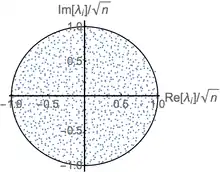Circular law
In probability theory, more specifically the study of random matrices, the circular law concerns the distribution of eigenvalues of an n × n random matrix with independent and identically distributed entries in the limit n → ∞.
It asserts that for any sequence of random n × n matrices whose entries are independent and identically distributed random variables, all with mean zero and variance equal to 1/n, the limiting spectral distribution is the uniform distribution over the unit disc.

Precise statement
Let be a sequence of n × n matrix ensembles whose entries are i.i.d. copies of a complex random variable x with mean 0 and variance 1. Let denote the eigenvalues of . Define the empirical spectral measure of as
With these definitions in mind, the circular law asserts that almost surely (i.e. with probability one), the sequence of measures converges in distribution to the uniform measure on the unit disk.
History
For random matrices with Gaussian distribution of entries (the Ginibre ensembles), the circular law was established in the 1960s by Jean Ginibre.[1] In the 1980s, Vyacheslav Girko introduced[2] an approach which allowed to establish the circular law for more general distributions. Further progress was made[3] by Zhidong Bai, who established the circular law under certain smoothness assumptions on the distribution.
The assumptions were further relaxed in the works of Terence Tao and Van H. Vu,[4] Guangming Pan and Wang Zhou,[5] and Friedrich Götze and Alexander Tikhomirov.[6] Finally, in 2010 Tao and Vu proved[7] the circular law under the minimal assumptions stated above.
The circular law result was extended in 1988 by Sommers, Crisanti, Sompolinsky and Stein to an elliptical law for ensembles of matrices with arbitrary correlations.[8] The elliptic and circular laws were further generalized by Aceituno, Rogers and Schomerus to the hypotrochoid law which includes higher order correlations.[9]
See also
References
- Ginibre, Jean (1965). "Statistical ensembles of complex, quaternion, and real matrices". J. Math. Phys. 6: 440–449. Bibcode:1965JMP.....6..440G. doi:10.1063/1.1704292. MR 0173726.
- Girko, V.L. (1984). "The circular law". Teoriya Veroyatnostei i ee Primeneniya. 29 (4): 669–679.
- Bai, Z.D. (1997). "Circular law". Annals of Probability. 25 (1): 494–529. doi:10.1214/aop/1024404298. MR 1428519.
- Tao, T.; Vu, V.H. (2008). "Random matrices: the circular law". Commun. Contemp. Math. 10 (2): 261–307. arXiv:0708.2895. doi:10.1142/s0219199708002788. MR 2409368.
- Pan, G.; Zhou, W. (2010). "Circular law, extreme singular values and potential theory". J. Multivariate Anal. 101 (3): 645–656. arXiv:0705.3773. doi:10.1016/j.jmva.2009.08.005.
- Götze, F.; Tikhomirov, A. (2010). "The circular law for random matrices". Annals of Probability. 38 (4): 1444–1491. arXiv:0709.3995. doi:10.1214/09-aop522. MR 2663633.
- Tao, Terence; Vu, Van (2010). appendix by Manjunath Krishnapur. "Random matrices: Universality of ESD and the Circular Law". Annals of Probability. 38 (5): 2023–2065. arXiv:0807.4898. doi:10.1214/10-AOP534. MR 2722794.
- Sommers, H.J.; Crisanti, A.; Sompolinsky, H.; Stein, Y. (1988). "Spectrum of Large Asymmetric Matrices". Physical Review Letters. 60 (19): 1895–1898.
- Aceituno, P.V.; Rogers, T.; Schomerus, H. (2019). "Universal hypotrochoidic law for random matrices with cyclic correlations". Physical Review E. 100 (1): 010302.